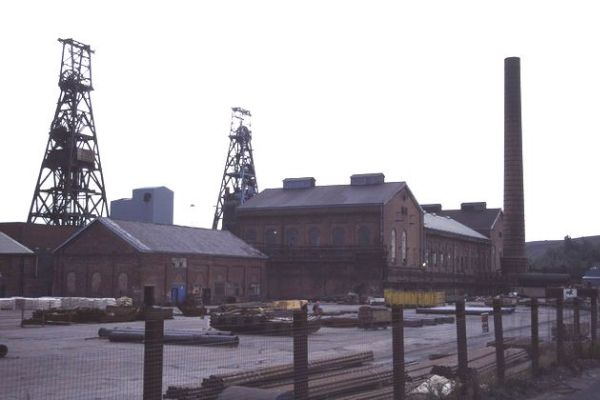
Rossington Colliery 1994
Copyright © Chris Allen and licensed for reuse under this Creative Commons Licence
The Rossington Main Colliery Co. Ltd was a subsidiary of the Sheepbridge Coal & Iron Co. and John Brown & Co. The former was working Cobnar Wood, Glapwell and Langwith collieries in Derbyshire, and the latter had Aldwarke Main and Car House collieries near Rotherham.
The site chosen was nearly 2.4 km west of Rossington, but it was convenient for a link to the L.N.E.R. line. It also left room to build miners’ housing on the intervening land. This became New Rossington Model Village which consisted of some 1,700 houses by 1940.
Sinking began at No.1 Shaft, which was 6.7 metre diameter, on July 10th 1912. Two weeks later, however, sinking stopped when the flow of water into the shaft became too great. Work resumed on February 21st 1913 and the Barnsley seam was reached, at a depth of 798 metres, on 3rd May 1915. That seam was worked throughout the colliery’s life. Sinking continued until the Dunsil seam was cut 14 metres below.
Work on No.2 Shaft started on June 26th 1912 and the six metre diameter shaft reached the Barnsley seam on November 7th 1915 and the Dunsil seam 11 days later. Pit bottoms were built at the Dunsil level and the Barnsley seam was entered by drifts.
Coal getting from the Barnsley began in July 1916 and continued until final closure in 2006. The Dunsil seam was also worked at various times (1917-22, 1925-27, 1955-58 and 1983-91) throughout the colliery’s life.
The Rossington Main Colliery Co. Ltd became part of Yorkshire Amalgamated Collieries Ltd in 1927, but continued trading under its own name until 1936, when it became Amalgamated Denaby Collieries Ltd. Other collieries in this grouping were: Cadeby Main, Darton Main, Denaby Main, Dinnington Main, Maltby Main, Rob Royd and Strafford, Silkstone. The latter company worked Rossington until it was nationalised in 1947.
Conveyors were used in the Barnsley seam from January 1933. Britain’s first flame-proof diesel locomotive was used underground at Rossington in 1939 for moving men and coal. Another was soon in use at Bentley colliery. From 1952 methane, extracted from strata near the faces, was piped from the mine and pumped ten miles to Manvers Main, where it fired coke ovens.
An improvement scheme in 1953 introduced 100 hp loco’s. A modernisation project in 1963-5 saw the building of a 48 metre high headgear, with electrically-powered friction winders at ground level, on both shafts. The latter were also deepened to the Swallow Wood Seam at 848½ metres from surface. This allowed 12 ton skips to be used in No.2 Shaft and larger cages in No.1 Shaft. Power loading was introduced and replaced hand getting in June 1964. Powered roof supports were used from September 1965.
The introduction of trunk conveyors and bunkerage to carry the coal from the face to the skips in the pit bottom began in 1969. On the surface a rapid loading scheme for merry-go-round trains opened in 1971.
The reserves of Barnsley seam on the east side of the colliery were developed from the mid-1980s and the old washery was replaced by a £5 million coal preparation.
In April 1993 Rossington was closed, but put on care and maintenance while a buyer was sought. It was reopened by RJB Mining (UK) Ltd as a private mine in July 1994. In 1996 Budge bought the mine an extended its operating license from ten to twenty-five years.
In 1999 RJB Mining (UK) Ltd became RJB Mining PLC, and in 2000 the mine passed to UK Coal Mining Ltd. The area of coal then being worked was, however, found to be affected by faulting, which seriously cut output. These losses and the cost of developing further resources led to UK Coal closing Rossington, with production ending on Friday March 31st. The site was demolished in 2007 and, after the tip was reworked and landscaped, it was designated for housing development.
Further reading:
- NMRS Records, Gazetteer of British Collieries
- Sections of Strata of the Yorkshire Coalfield, Midland Institute of Mining Engineers, 1927
- Hill, A. The South Yorkshire Coalfield: A History and Development (Stroud: Tempus, 2002)
- Hill, A. Colliery Ventilation (Matlock: Peak District Mines Historical Society Ltd, 2000)
- Hill, A. Coal: A Chronology for Britain (NMRS, British Mining No.94, 2012)

